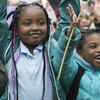EarthFest is no longer just a day, it’s a series of events held throughout the year. Now part of the Ambler Arboretum, EarthFest programming is developed working closely with Arboretum educators, the Temple Ambler Field Station and other University partners such as the Department of Biology, the College of Science and Technology, Recreation, Outdoor Education and Wellness at Temple Ambler and the University’s Office of Sustainability.
Online citizen scientists may take deep dives into any number of environmental topics with virtual celebrations of World Water Day, Earth Day, Arbor Day, the Great American Campout and the Science of Scary.
“We realized that the important themes of EarthFest — sustaining our communities, environmental education and awareness, preserving animal habits, STEM education, emergency management, living healthy — really couldn’t be contained to a single day,” said Duffy. “Building on what we’ve been able to achieve with a single event, we now host a variety of events designed to get people really thinking about the world around us.”
EarthFest events today are designed to provide more personalized opportunities to interact with exhibitors and for students to get hands-on with citizen science. Planned Ambler Arboretum EarthFest events in 2024 include the return of favorites such as the Science of Scary, World Water Day and a campus bioblitz in addition to new programs focused on the importance of dark skies, diversity in the sciences and World Food Day, which brings awareness to global food insecurity.
"One of the great things about holding these events on campus is that we have an opportunity to help people understand what plants are a little better, what plants do, and their role within the greater system," said Kathy Salisbury, Director of the Ambler Arboretum of Temple University. "We can't exist without plants. Our future depends on how we interact with the world around us."
EarthFest is about providing visitors food for thought and the fuel to power engines for positive change, said Dr. Amy Freestone, Director of the Temple Ambler Field Station.
“For any of these programs, we want visitors to come away with new understanding, an appreciation for our environment, and hopefully ways to integrate this new appreciation into their daily lives,” she said. “The partnership between the Temple Ambler Field Station, the Ambler Arboretum and EarthFest has enabled us to communicate our research to the public — to share what we have learned, and to highlight why this is important.”
Many people have heard about climate change and changing weather patterns, Freestone said, “but this can feel abstract and not relevant to people's daily lives.”
“We hope that by sharing our research on the recovery of a forest after a severe weather event, such as the tornado that struck Temple Ambler in September 2021, or any of our other research endeavors, that it makes abstract concepts feel concrete, while highlighting ways we are still learning and creating new knowledge to address big environmental challenges,” she said.
Twenty years on, the creation of EarthFest continues to be a point of personal pride for Schlotterbeck.
“I still refer to it as my biggest professional accomplishment. I think EarthFest today and in the future provides a natural distillation for what the Ambler Campus and surrounding communities have dealt with in recent years — it’s amazing the amount of resilience that is in everybody’s spirit,” he said. “Clearly the campus community has done a wonderful job in trying to regroup and repurpose some of the things that the campus has been known for. EarthFest in 2023 and beyond can educate the community in the ways that the campus itself is recovering.”
Moving forward, Nancy Featherstone said, she would like to see EarthFest continue to evolve and grow “and be even more robust in a way that brings young people into the fold about what they can do to have an impact on their own environment.”
“I think the whole idea is focused on keeping an eye to the future. What can we do to support continued growth and development in a sustainable, ecological way,” she said. “What are the individual responsibilities we all have? We need to do more around reuse and recycling, mass transportation, scaling back on our use of carbon fuels and all of those principles. My hope is that part of Jeff’s legacy is training tomorrow’s leaders and I’m confident that will happen.”
We’ve just scratched the surface in terms of sustainability and environmental stewardship, Nancy Featherstone said.
“There is so much yet to do, and each person can do something. If you help people know what they can do, most people are willing and excited to do their part,” she said. “I think EarthFest has been and will continue to be an essential avenue in giving people the tools they need to protect and preserve their future.”
Learn more about Temple Ambler EarthFest at https://ambler.temple.edu/earthfest.

